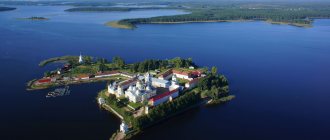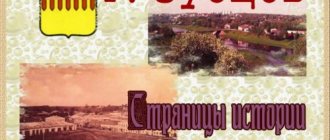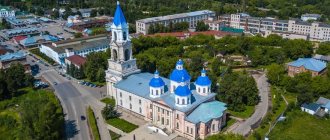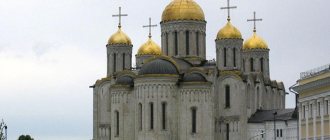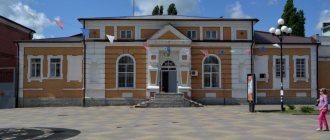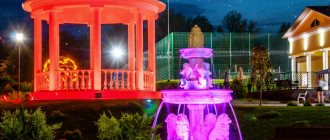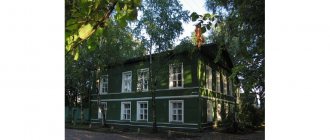| Torzhok |
Torzhok
, a city in Russia, the administrative center of the Torzhok district of the Tver region, within the Tver diocese. Located on the banks of the Tvertsa River, a tributary of the Volga, 60 km northwest of Tver, on the Moscow-St. Petersburg highway. A branch of the Oktyabrskaya Railway to Rzhev, Likhoslavl, Ostashkov passes through the city. Population: 46,031 people (2017).
- On the map: Yandex.Map, Google map
Torzhok is one of the oldest cities in the Upper Volga region.
It is one of 116 Russian cities whose historical and architectural centers have been declared protected areas. The territory of the city is a unique complex of architectural and archaeological monuments. In terms of the number of monuments, Torzhok surpasses all cities of the Tver region (292 objects, including 92 monuments of federal significance, 102 of regional significance and 98 newly identified objects). The total area of the medieval cultural layer is 150 hectares. The city was first mentioned in the chronicle of 1139, but it apparently arose back in the centuries. In the “Topographic and Historical Description of the City of Torzhok in 1783-1784” the time of the city’s foundation is stated:
“The time when and by whom the city of Torzhok was founded, although it is impossible to accurately determine, its antiquity is confirmed by reliable incidents, for the founder of the Boris and Gleb Monastery located in Torzhok, the Reverend Father Ephraim, lived at the beginning of the 11th century and was in the service of the Grand Dukes of Russia Boris and Gleb; After they were killed in 1015, intending to spend the rest of his life in solitude, he came to this city, which at that time was already crowded, and Saint Ephraim was then appointed Archimandrite of the Boris and Gleb Monastery.”
.
On the right bank of the Tvertsa River, in the 12th century, a trade and craft settlement of the Novgorod Slavs was formed - Novy Torg
.
Subsequently, the city began to be called Torzhok
. The presence of a waterway, convenient location, and the development of trade and crafts contributed to the growth of the city.
In the 14th century, the entire city within the cape between the Tvertsa River and its tributary the Zdorovets stream was surrounded by wooden walls with towers, and on the southern side it was protected by a high earthen rampart and a ditch. This is how the Torzhok Kremlin was formed. On its territory there was a wooden temple and a veche square. In 1364, on the site of the wooden cathedral, a stone one was built, which in 1822 was replaced by the five-domed Transfiguration Cathedral, built according to the design of the famous architect C. Rossi. The Torzhok Kremlin was at one time a significant fortress that withstood long sieges. So, in 1238, the Novotors held back the hordes of Batu Khan for two weeks. More than once the Novgorod princes took refuge behind the walls of the Torzhok Kremlin.
During the internecine war in 1372 between Prince Mikhail Alexandrovich of Tver and Grand Duke Dmitry Ivanovich Donskoy, Torzhok suffered the greatest devastation, was practically reduced to ashes, and some of the inhabitants were chopped down and drowned in Tvertsa, and the rest were taken to Tver and settled in a special settlement.
In 1478, republican rule was abolished in the city, the city was annexed to Moscow and began to be governed by royal governors from the boyars. The city continues to grow. The Kremlin is surrounded by trade and craft areas. The urban area also extends to the left bank of the Tvertsa.
The role of the city as an important trading point on Tvertsa especially increased under Peter I, when the Vyshnevolotsk water system, which included the Tvertsa River, was built to transport goods to St. Petersburg under construction. The city and its district supplied grain, flour, hemp, leather, and building materials to the new capital. At the same time, Torzhok was one of the most important postal stations on the “sovereign road”.
Since 1708 - as part of the Ingermanland province (from 1710 - St. Petersburg), since 1719 - Tver province. Since 1727 - as part of the same province in the Novgorod province. Since 1775 - the district center of the Tver governorship (since 1796 - the Tver province).
| Torzhok. View from the west. Tvertsa River. Summer 1910. Photo by S. M. Prokudin-Gorsky from the site prokudin-gorskiy.ru |
In 1781, the general plan of the city was approved, which was the main construction document for a century and a half.
During this period, many stone buildings were built in the center of Torzhok. Experts call the second half of the 18th - first half of the 19th centuries the “golden age” of Torzhok, which transformed the face of the city. Nikitin, Kazakov, Lvov, Rossi and other outstanding architects worked on its architectural appearance. Then new administrative complexes, shopping arcades, and many stone residential buildings of nobles and merchants appeared in the city. In place of the old ones, new cathedrals and churches were erected, and the remaining churches were rebuilt. Of course, with such a large-scale construction, the old architecture of Torzhok could not help but suffer, but it was replaced by a complex, artistically completed urban ensemble in the unified style of classicism. It is thanks to this that modern Torzhok is considered an example of Russian urban planning art of the 18th-19th centuries.
.
In 1856, in the county town of Torzhok, Tver province, there were 27 churches, 2,234 houses, 394 shops.
Since the beginning of the 19th century, leather, shoe, and blacksmithing industries have developed. At the end of the 19th century, a school of gold embroidery arose on the basis of artels of gold seamstresses.
With the beginning of the construction of railways, shipping along the Vyshnevolotsk system began to decline, and the economic life of the city froze.
By 1917, Torzhok had turned into a provincial merchant city.
At the beginning of the 21st century, the city has a carriage building plant, a printing ink plant, a shoe factory, and woodworking and food industry enterprises. The school of artistic embroidery and the gold embroidery factory (lace embroidery with gold, silver and silk on morocco and velvet) are famous. An ancient folk craft - a clay toy - has been revived.
Statistics
- 1856 - 10.2 thousand people
- 1913 - 14 thousand people
- 1931 - 17 thousand people
- 1967 - 43 thousand people
- 1992 - 50.2 thousand people
- 2006 - 48.2 thousand people
History of Torzhok
On the Tvertsa River in the 10th century, the future regional center of the Tver region of Russia, the city of Torzhok, was founded. The exact date of formation of this settlement is unknown. Historians found the first mention of this ancient Russian city in the Novgorod Chronicle of 1139. It talks about the seizure of a trade and craft settlement by the Rostov-Suzdal prince Yuri Dolgoruky. At that time the city was called “New Torg”. After some time, “Novy Torg” was renamed “Torzhok”. The name of the city itself arose from the word “torg” (to trade). It was convenient for Novgorod merchants to conduct trade, since the trade route from Novgorod to neighboring principalities passed along the river. To get to Novgorod and other large cities at that time, trade caravans had to drive or sail through Torzhok. In those days, the city was a kind of border point. Torzhok was often ruined during the Russian internecine wars, but thanks to its extremely convenient commercial geographical location, the city quickly recovered. Torzhok suffered the most twice in its history: in 1238 during the invasion of the Tatar-Mongol yoke under the command of Batu, and in 1569, when the troops of the first Tsar of All Rus', Ivan the Terrible, barbarously passed through Torzhok during a punitive campaign against Novgorod and Pskov.
The city experienced its real dawn in the 18th and 19th centuries. For example, during the construction of St. Petersburg in 1709, the Tveretsky Canal was built, since Torzhok was on the way from Moscow to St. Petersburg. From 1775 and for 142 years, Torzhok was considered a provincial district town. 12 years after the 1917 revolution, the districts were abolished, and in 1930 Torzhok became the administrative center of the Torzhok region. Now Torzhok is considered one of the 116 historical cities of Russia, where cultural monuments included in the list of city attractions are located on an area of 59 km.
TOP 4: what to see in Torzhok in 1 day
The entire city can be called one big attraction; around every turn there are unusual buildings and amazing natural landscapes.
Novotorzhsky Kremlin
- Address: Staritskaya st., 1.
Wooden buildings were erected on the site where the Kremlin stood in ancient times. The Kremlin was called Novotorzhsky after the old name of the city - New Torg. The value of this attraction is not so much in the buildings, but in the events held here.
The Kremlin hosts festive celebrations and spectacular battle reenactments. Visitors can practice archery, view torture instruments and a collection of ancient weapons.
In recent years, themed weddings have been held, stylized according to the ancient traditions of matchmaking, marriage and festive feasts. There is also an observation deck on the Kremlin ramparts, which offers stunning views of the entire city.
Park of Love and Fidelity
- Address: st. Dzerzhinsky, 73.
On the banks of the Tvertsa River, near several museums, a truly fabulous corner opens up to tourists. The small cozy park is decorated with white boardwalks, bridges, flower beds and interesting sculptures. The snow-white twisted carriage and the Bench of Reconciliation are wonderful places for photo sessions. The park offers a wonderful view of Tvertsa.
Pushkin's square
- Address: pl. Pushkin.
Several centuries ago, the square was a place of lively trade and was called Khlebnaya. Bread, flour and grain were the main goods of local merchants. In 1973, Khlebnaya Square was renamed Pushkin Square and a monument to the poet was erected on it.
Tveretskaya embankment
- Address: Tveretskaya emb.
The city embankment is beautiful not only from a landscape point of view, but also from an architectural point of view. Along the Tvertsa River stretches a number of ancient facades, on which restorers worked, giving the buildings a single image of pre-revolutionary merchant houses.
Walking along the cozy embankment, you can plunge into the atmosphere of antiquity, merchant life, and feel like you are part of a bygone era. Nature lovers can enjoy the green landscapes, breathe fresh air and even feed the ducks.
Sights of Torzhok
Torzhok has many interesting attractions, so it will be extremely comfortable to spend a weekend in this city. However, there is a small law - when going to Torzhok, take a camera with you. Or better yet, two at once! Torzhok is so beautiful that a memory card may not be enough for photos
